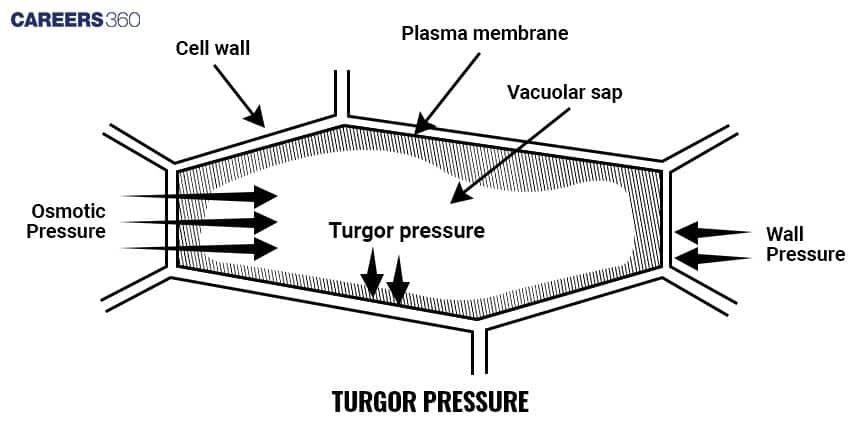Differences Between Turgor Pressure and Wall Pressure: Overview, Examples
Turgor pressure is the outward force exerted by the fluid-filled vacuole against the cell wall, while wall pressure is the inward opposing force applied by the rigid cell wall. Together, they maintain plant cell rigidity, prevent bursting, and ensure structural stability — key concepts in plant physiology.
This Story also Contains
- What is Turgor Pressure?
- What is Wall Pressure?
- Role in Plant Physiology
- Measurement of Turgor and Wall Pressure
- Differences Between Turgor Pressure and Wall Pressure
- What Happens When Turgor and Wall Pressure Are Imbalanced?
- Turgor vs Wall Pressure NEET MCQs (With Answers & Explanations)
- Recommended video on Turgor Pressure and Wall Pressure

What is Turgor Pressure?
Turgor pressure is the inward pressure exerted by the fluid, contained within the central vacuole of a plant, exerted on the cell membrane. This pressure maintains or holds up the form and rigidity of the cell.
Definition
Turgor pressure is the pressure of the fluid within the vacuole pushing out against the cell membrane that, thus, aids the cell in maintaining firmness and its structural integrity.
Formation
It is formed when water enters the cell by osmosis, expands the vacuole, and increases its pressure on the cell wall.
Importance and Role
İt holds the form of the cell, and provides mechanical support to the structure of the plant, working as the driving force standing behind the cell's expansion.

What is Wall Pressure?
Wall pressure is the force of the cell wall opposite of turgor pressure. It is the counter pressure exerted by the rigid cell wall of a plant cell against its content. It balances the internal pressure created by the vacuole and hence helps to maintain the shape of the cell. It resists excessive expansion.
Definition
Wall pressure is a physical pressure exerted by a rigid cell wall that counters the turgor pressure from within.
Formation
This is caused by the resistance that the cell wall gives to the internal pressure of the expanding vacuole.
Significance
The wall pressure keeps the cell intact against overexpansion and rupturing in the cell.
Role in Plant Physiology
The role of turgor pressure and wall pressure in plant physiology is:
Maintains turgidity and the upright posture
Supports cell growth
Helps in the opening and closing of stomata in leaves
Essential for regulations of water potential in cells
Prevents collapse during water stress i.e, drought or flood
Measurement of Turgor and Wall Pressure
The turgor pressure can be measured according to the changes in the volume of the cell and the pressure therein with changes in the varied osmotic conditions.
The measurement of the wall pressure may be indirectly derived from the balance between turgor pressure and rigidity in the cell wall.
WP = TP − Diffusion Pressure Deficit (DPD)
Differences Between Turgor Pressure and Wall Pressure
Knowing how these two forces are in contrast helps to illustrate their contributions to cellular mechanics and plant physiology.
Parameter | Turgor Pressure | Wall Pressure |
Definition | Pressure exerted by fluid within the vacuole against the cell membrane | Pressure exerted by the cell wall against the cell contents |
Formation | Created when water enters the cell, increasing vacuole pressure | Caused by the resistance of the cell wall to internal pressure |
Direction | Exerts outward pressure towards the cell wall | Exerts inward pressure towards the cell contents |
Function | Maintains cell shape, supports plant structure, and drives growth | Prevents overexpansion of the cell and maintains structural integrity |
Measurement | Measured directly through changes in cell volume and osmotic conditions | Indirectly derived from the balance between turgor pressure and wall rigidity |
Impact on Cell Shape | Provides rigidity and stiffness to the cell | Opposes turgor pressure to prevent bursting of the cell |
Interaction | Forces against the cell wall | Counteracts turgor pressure, providing balance |
What Happens When Turgor and Wall Pressure Are Imbalanced?
There are three conditions possible:
Turgor > Wall Pressure (Cytolysis)
When turgor pressure is more than the wall pressure, excessive water enters the cell, causing it to swell or burst.
Turgor < Wall Pressure (Plasmolysis)
When water leaves the cell, turgor pressure decreases. As a result the cell membrane shrinks from the cell wall, making the cell flaccid or plasmolysed.
Turgor = Wall Pressure (Equilibrium)
When both pressures are balanced, the cell remains turgid, and healthy, maintaining optimal physiological functions and structural stability.
Turgor vs Wall Pressure NEET MCQs (With Answers & Explanations)
The key concepts to be covered under this topic for different exams are:
Measurement of Turgor and Wall pressure
Turgor vs Wall pressure
Practice Questions for NEET
Q1. Which of the following elements is responsible for maintaining turgor in cells?
Potassium
Sodium
Magnesium
Calcium
Correct answer: 1) Potassium
Explanation:
Potassium is required for the maintenance of the turgidity of guard cells. In the guard cells, starch is converted into malic acid in the presence of light (during daytime).
Protons formed are used by the guard cells for the uptake of K+ ions. In this way, the concentration of K+ ions increases in guard cells. The potassium combines with malate to form potassium malate.
This increases the solute concentration of the guard cells. The guard cell withdraws water from the nearby cells and becomes turgid.
Hence, the correct answer is option 1) potassium.
Q2. To maintain a functional volume, the cell should be placed in
Isotonic solution
Hypotonic solution
Hypertonic solution
All of these
Correct answer: 1) Isotonic solution
Explanation:
To maintain optimal functionality and structural integrity, a cell must be situated in an isotonic solution. An isotonic medium is characterized by possessing an osmolarity equivalent to that of the cell's cytosol, ensuring equilibrium in the distribution of solutes such as salts and sugars. Under such conditions, there is no significant net water movement across the cell membrane, thereby allowing the cell to retain its typical form and volume, which is essential for its vital processes.
Conversely, exposure to a hypertonic solution, where solute concentration is higher externally, would induce water to exit the cell, leading to cell shrinkage and potential damage in animal cells known as crenation, or plasmolysis in plant cells. On the other hand, placement in a hypotonic solution, with a lower solute concentration outside, would result in water influx, causing the cell to swell. This could culminate in the lysis of animal cells due to osmotic pressure, or an increase in turgor pressure within plant cells, which, though beneficial for certain processes like photosynthesis, can be detrimental if not controlled properly. Thus, the isotonic environment is ideal for cellular stability.
Hence, the correct answer is option 1) Isotonic solution
Q3. If turgor pressure becomes equal to wall pressure then
Water leaves the cell
Water enters the cell
No exchange of water takes place
Solute goes from the cell into water
Correct answer: 3) No exchange
Explanation:
Wall Pressure -
The cell wall, being rigid and elastic, exerts an equal and opposite force (as compared to turgor pressure) on the protoplast. If turgor pressure becomes equal to wall pressure then no exchange of water will take place due to no pressure difference.
Hence, the correct answer is option 3) No exchange.
Recommended video on Turgor Pressure and Wall Pressure
Frequently Asked Questions (FAQs)
The pressure provides shape to the cell, supports plants, and enables growth by pushing the cell membrane against the cell wall.
Wall pressure is important in that this counterbalances the turgor pressure, avoiding the bursting of the cell and thus preserving the structural integrity of the cell.
Turgor pressure may be viewed by alterations in cell volume and conditions of osmosis; wall pressure is determined based on equilibrium between turgor pressure and rigidity of the cell wall.
This now becomes the pressure that the vacuole fluid exerts inwards on the cell membrane. This makes the cell turgid, hence strong enough to give support to the cell.
Mechanical pressure exerted by the cell wall, that opposes or resists the pressure that is developed from within by the turgor, thus preventing excessive dilation and maintaining the cell's shape.